

© Shipping Wonders of the World 2012-

Raising the “Maine”
A mysterious explosion sent the United States battleship “Maine” to the bottom of Havana Harbour, Cuba, on February 15, 1898. Fourteen years later the battleship was refloated after extensive salvage operations. Contrary to expectations, the cause of the explosion was not definitely ascertained
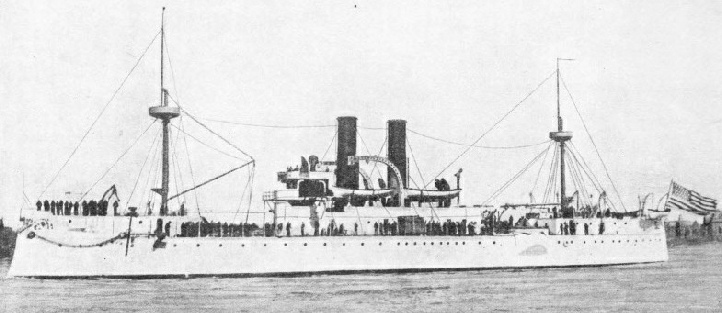
THE DOOMED VESSEL. The battleship Maine was sent by the U.S. Government to Havana, Cuba, to protect the interests of American citizens. She arrived on January 25, 1898, and blew up at 9.40 in the evening of February 15. The Maine, of 6,650 tons displacement, was built at New York in 1890. Her length was 324 feet, her beam 57 feet and her draught 21 ft. 7 in. Her engines, with an indicated horse-
THE loss of the American battleship Maine, in Havana Harbour, in 1898, was something more than a tragedy involving the deaths of two officers and 258 men, for it swept away any chance of the United States and Spain settling their differences peacefully, and precipitated war between the two nations.
In 1895 a rebellion flamed up in Cuba which a Spanish army of 200,000 men was unable to quell, whereupon the Spaniards adopted such harsh measures that by the end of 1897 the whole of Cuba was faced with starvation.
Feeling a generous sympathy for the natives, the people of the United States were incensed against the methods of the Spaniards, who, in their turn, were angered by the attitude of the Americans. The tension was such that the Government of the United States decided to send the Maine to Havana as a protection to American citizens.
The Maine arrived at Havana on January 25, 1898, and was allotted a mooring by the harbour authorities. Here she remained, dominating the city with her guns, and regarded by the Spaniards as an open threat, until a mysterious explosion sent her to the bottom at 9.40 in the evening of February 15. The American people promptly concluded that the explosion was due to the treachery of the Spaniards. The general opinion was that a mine had been placed secretly in position under the keel of the battleship and detonated, so that the two forward magazines of the ship had exploded and carried her to the bottom.
The Spaniards denied the charge. Their divers went down and reported that, so far as they could see, the keel of the battleship did not appear to be injured. If this were so, it seemed impossible that a mine could have been exploded under her, and it rather looked as though the catastrophe was one of those occasional and terrible tragedies due to the spontaneous combustion of the explosives in the magazines.
The American divers, however, reported later that the keel was broken; but the mystery remained to perplex many minds, while the Spanish-
In the years that followed that war a strong feeling grew up in America that the wreck of the Maine should be raised from Havana Harbour so that the bodies of those who died in her could be recovered and the mast of the battleship set up as a public memorial in Arlington National Cemetery. In doing this it was naturally hoped that the mystery of the explosion which destroyed her would be solved. In May 1910, therefore, Congress voted $100,000 or about £20,000, and instructed the Chief of Engineers of the War Department to raise the wreck.
It was a most difficult problem, and although the Chief of Engineers had no doubt that it could be accomplished, he knew quite well that it would never be done at a cost of £20,000. In the end Congress voted £180,000 to carry through the work, and the eventual cost of raising the Maine amounted to $789,865, or about £158,000.
In the minds of the three engineers, Colonel W. M. Black, Lieut.-
The engineers decided that, as the Maine before the explosion was 324 feet long, with a beam of 57 feet, their coffer-
In due course they began building the cylinders of steel piles which interlocked. As the sea was 30 feet deep, with the soft mud below another 30 feet in depth, it was considered necessary to drive the piles for 10 feet into the stiff clay to hold them upright and rigid. If the cylinders were to come 5 feet above water, this gave them a minimum length of 75 feet.
The engineers realized that piles of this length would be extremely difficult to handle, so they had the piles made in lengths of 50 and 25 feet, and of 40 and 35 feet, each pair being fastened together to make up the length. They drove the 50-
A pile was driven to mark the centre of the cylinder. The Americans secured a circular wooden frame to the cylinder to serve as a guide for the driving of the steel piles.
In the course of time they had four pile drivers on the spot to push forward the work. All day long their monotonous clanging echoed across the harbour as they drove the steel down into the hard clay.
Amazing Force of the Wind
As the teams got into their stride they learned a dozen little tricks to ease the labour of handling the unwieldy piles, but unexpected checks still slowed them down to such an extent that they could average only thirteen piles driven in a day.
Now and again a pile twisted as it was being driven and slipped out of the interlocking edge. There was nothing they could do except pull it out again and drive it afresh, for any weakness in a cylinder would have imperilled the whole work. It was therefore essential to see that the cylinders were as perfect as they could make them.
Strange to say, one of the big drawbacks they had to contend with was the wind. Early in their work they found that the pressure of the wind at times was sufficient to bend a steel pile, incredible as it may seem. Later they had an amazing manifestation of the force of the wind. It blew with such strength upon the face of a nearly completed cylinder that it forced the cylinder out of the vertical.
When the engineers found out what had happened they tried all they knew to bring the cylinder into an upright position again. They could not do it so they were obliged to drive the few piles to complete it at a slight angle, instead of upright. That cylinder remained from first to last leaning at an angle so that it resembled a submerged Tower of Pisa.
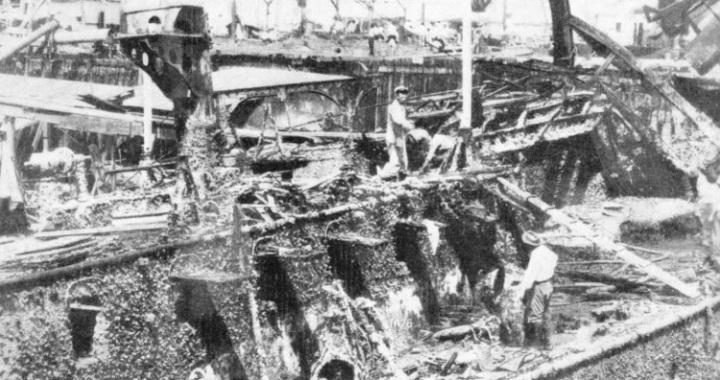
THE STARBOARD SIDE of the Maine and part of the superstructure as it was revealed on June 21, 1911, after the water in the coffer-
Another difficulty came on them unexpectedly and compelled them to modify their original plan. This was a variation in the depth of the mud It. was reasonable to suppose that the bed of clay at the bottom of the harbour was virtually level. The soundings and tests indicated that this was so, and the stiffness of the clay seemed to ensure it. When, however, they came to drive the piles of some of their cylinders they found the mud in places was two feet deeper than they had expected.
The engineers had calculated to a nicety the pressure of wind and water that their cylinders would have to withstand. With the piles driven 10 feet into the clay the officers had no doubt that they could hold the cylinders securely in position. But everything was jeopardized if the piles of some cylinders were driven no more than 8 feet in the clay. At the crucial moment these cylinders might carry away or rupture and spread disaster to the men inside the coffer-
Not for a moment dare the engineers take the risk. All the piles were already manufactured and on the spot. There was only one way that they could see of making the work safe. That was to drive their piles through the deeper mud a full 10 feet into the clay, and to drive all the other piles a further 30 in. into the clay, so that the tops of the piles remained at one level above the surface.
In the end, instead of their coffer-
When they came to build the tenth cylinder, which was at the bow of the wreck, they found the mast had been thrown forward by the explosion and was right in the way of their work. They were compelled to shackle it up and haul it out with a 50-
It was December 6, 1910, when they drove the first pile. Not until March 31, 1911, was the last pile locked and driven into place. In that period they drove 3,190 piles — a job that cost
£25,000 for labour alone. There was in all that period just one red-
Directly the cylinders were completed the engineers began the task of filling them to make a wall that would keep out the sea and enable the interior of the coffer-
Filling the Cylinders
To obtain the filling from land would have been a lengthy and costly business. Fortunately there happened to be a shoal within 200 or 300 yards of the coffer-
They tried grabbing huge mouthfuls of it, then they tried scooping it up, but the quantity they were able to take out in a day was so meagre that the job promised to last for ever. Even these poor results threw such a strain on the dredger that it was always breaking down and had to be overhauled. So frequent were the delays that the engineers eventually gave up the idea of using this dredge. Luck was with them, for at that time there happened to be delivered to a contractor in Havana a new suction dredger, which the engineers were allowed to test on the understanding that it would be hired if satisfactory. It proved capable of doing the job.
But the new type of dredger brought new problems. The salvage men were expecting to shoot into their cylinders a solid material that was almost free of water, instead of which the suction dredger delivered clay and water. It was anticipated, because of the hardness of the clay, that it would come through in fair-
Things did not happen exactly as anticipated. In the first place it was found that filling a cylinder which had an empty cylinder on either side of it placed too great a strain on it and distorted it. The engineers modified their method and, instead of filling a cylinder at a time, they poured a foot or two in one, then shifted the delivery pipe to the next to fill it with a similar quantity, and so on all the way round. By filling the cylinders thus in layers, they ensured that the pressure inside them would be equal all round the cofferdam and the danger of distortion and rupture would be nullified.
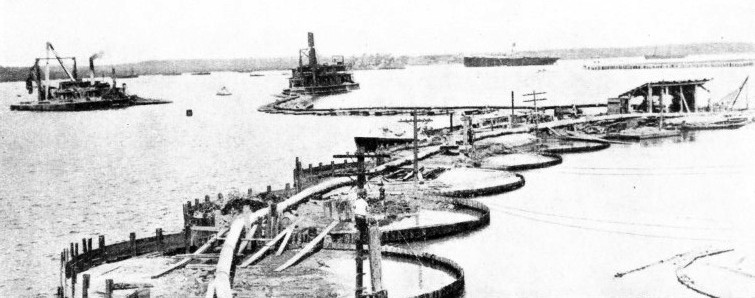
THE COMPLETED COFFER-
The engineers were far too clever to build the cylinders to touch one another. Some distortion was bound to take place when the cylinders were filled, and if they were touching one another and had no room for expansion a number of them might rupture. To avoid this contingency a space of 8 in. was left between every cylinder and its neighbour, and into this space was driven a pile made from the trunk of a palm. As the cylinders expanded while being filled, the fibrous palm pile acted as a buffer between the two cylinders which compressed the fibres of the wood until it was wedged solidly into the space.
Trouble occurred, however, early in the filling, for one of the cylinders burst and spilled most of its contents. At once the engineers recollected that a pile in this cylinder had given them trouble in driving it and that it had not gone home so smoothly as the others. They found now that the interlocking edge had slipped out down below, and this was sufficient to weaken the cylinder to such an extent that it burst, the piles bending on either side of the break.
There was nothing for them to do but to pull out the bent piles — there were eleven of them — and drive new piles to remake the cylinder. Although they pulled out eleven piles, they had to drive in thirteen to complete the gap. It indicates the expansive forces exerted by the downward pressure of the huge mass of material, which probably amounted to about 4,000 tons in each cylinder. One test they made showed a bursting pressure of 8 tons to the square foot, and the interlocking edges of the piles were tested to stand a strain of 4 tons to the linear inch.
Tens of thousands of tons of clay moved through the pipe of the dredge into the cylinders. The shoal was eaten away and pumped into the coffer-
Three days earlier another cylinder had collapsed. There was no question this time of a pile slipping out of the interlock in driving, for an examination disclosed a fault down the centre of the pile. It was not noticeable to the eye, and was not detected in driving, but it gave way at once under the weight it had to bear. The cylinder opened and the piles on either side of the break were bent to such a degree that it was necessary to pull out forty-
The Coffer-
The clay in the cylinders was plastic and saturated with water, and therefore had to pack down solid and dry before it could act as a barrier to keep out the sea. As the sun and wind played on the surface, the clay began to solidify, and in a few days men were able to walk about on it without breaking through the crust. This was a promising sign.
It was the under-
To get rid of the water and dry out the clay was the question which exercised their minds. In the end, just as they had been compelled to fill the cylinders in layers, they decided to dry them out m layers. There was no method by which they could drain the water from the clay by pumping inside the cylinders. They therefore pumped the water from the area inside the cofferdam, and lowered the level by a depth of 5 feet. This exposed the inner sides of the cylinders to sun and air and dried out another layer of the contents.
The inner halves of the cylinders exposed to sun and air naturally dried out faster than the sides exposed to the sea, where the water all the time was seeping through the joints of the piles. The engineers thereupon put in much work removing this inner dry layer and piling it on the outer edge of the cylinders. The wet clay on the outer sides packed down under the pressure of the dry clay above it and, in the end, by lowering the water inside the cofferdam 5 feet at a time and allowing it to remain at this level until the clay had dried out to a similar level, they were able to pump out the coffer-
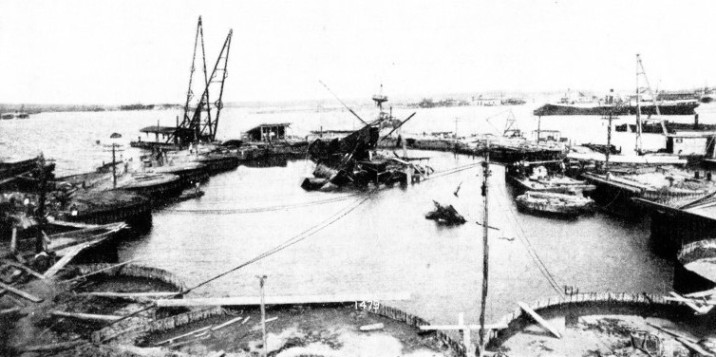
HUGE CYLINDERS, each 48 feet in diameter and 75 feet deep, formed the elliptical coffer-
While the pumping out was going on, all the tops of the cylinders began to move inward because of the pressure of the sea on their outer faces. The engineers did all they could to stop this action. They dumped thousands of tons of stone against the foot of the coffer-
entirely stopped the movements of the cylinders, and cylinders on opposite sides of the ship moved inward toward each other just over 21 feet.
The scene inside the coffer-
The wreck of the Maine, now revealed to human eyes, was a strange sight. The inside of her was deep in horrid mud. Where the mud had failed to cover her, sea growths had taken charge and laid their thick encrustations over her. Not one little bit of wood remained of her interior fittings it had all been riddled and eaten away by the boring worms that infest the sea.
In those tense days following the catastrophe the Americans had no doubt that a break in the keel of their battleship was proof of the explosion of a mine outside her, and the finding of the Court of Inquiry under Admiral Sampson confirmed this view. The evidence to-
The forward part of the ship where the magazines were situated was completely destroyed, as was the boiler space aft of the magazines. The keel was found to be almost vertical at this point and broken in three places The sides were blown outwards, and the protective deck had been blown upwards before collapsing down again.
So far as can be judged from the reports of the damage, the initial fracture and the setting up of a portion of the keel in a vertical position were more likely to be due to the explosion of the inner magazines than to any initial explosion of a mine outside. As the disruptive forces were unleashed they would thrust up and carry the bow of the ship with them. This would make the stern swing down and hit the bottom, only a few feet below.
Floated Out and Sunk
With the enormous power of the explosion still forcing the bow up, and the bottom suddenly preventing her stern from swinging down, her keel would tend to fracture just aft of the magazines, where, in the Maine, it was broken. At the same time the explosive forces would thrust downward at the keel to break it in other places, they would expand outward at the sides and backward into the fairly open boiler spaces, and in driving forward they would twist and play havoc with the bow of the ship.
This suggests that the destruction of the Maine was caused by the deterioration of her explosives and not by the explosion of a mine. Admiral R. M. Watt, who was a member of the Board of Inquiry, has expressed the opinion that this theory is wrong. Yet during the war of 1914-
After having removed all the debris of the forward part of the Maine by blasting and cutting it with oxy acetylene cutters, the salvors built a strong bulkhead of timber 3 in. thick across the afterpart of the vessel to enable her to float. Their method of freeing the stern from the bed of clay into which it had burrowed was most ingenious. They cut twenty-
On February 3, 1912, the coffer-
A huge concourse of people gathered round the harbour to see the wreck taken out to sea on the afternoon of March 16, 1912. The tugs towed her into deep water, where the special flooding cocks were opened, and at 5.21 p.m., with the Stars and Stripes flying, she vanished beneath the waves.
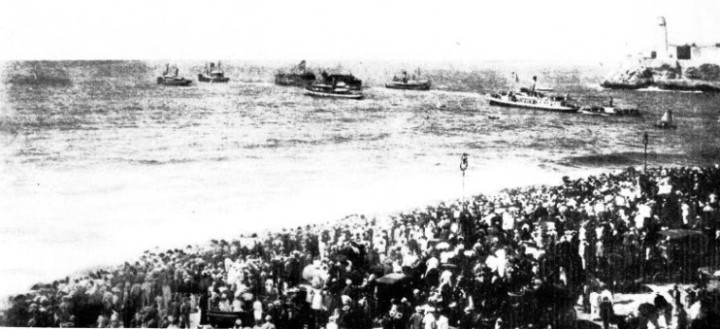
TOWING THE AFTER PART of the Maine out of Havana Harbour on March 16, 1912, a month after she had been raised. The tugs towed her into deep water, where the special flooding cocks were opened. At 5.21 p.m., with the Stars and Stripes flying, she vanished beneath the waves. Huge crowds lined the shore to watch the final operations.
You can read more on “American Shipping”, “Raising the German Fleet” and “The United States Navy” on this website.